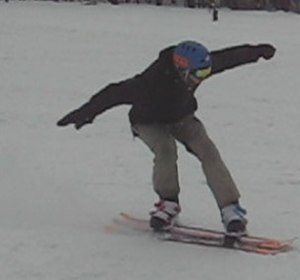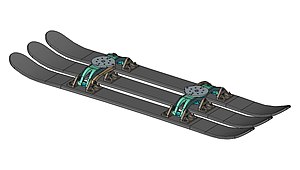Snowglider

There is this on-going rivalry between skiing and snowboarding sport disciplines as both have their pros and cons, but snow conditions are one of the most significant variables impacting the skiing and boarding experience because snow conditions influence the ability to maintain speed, to cut turns and to recover from falls.
Snowglider is a snow sport concept that solves the issues with difficult snow conditions. A snowglider has 2 or 3 skis, held together with 2 rotation bridges and by slightly turning the feet vertically, the skis rotate around the horizontal axis. This gives more edge length and as a result gives amongst other advantages increased control, less chance of tripping over and higher speed.
Snowglider mainly addresses the Alpine skiers, the Freeride snowboarders and Freecarve snowboarders.
History[edit]
In 2006 inventor Kristof Geilenkotten was taking his kids ons a skiing trip while trying to keep up with his skiing kids while being himself on a snowboard. The fact that the snowboard had fewer egde caused him to fall behind and the idea of parallel ski's tied together to increase the edge and as such increase the control using a snowboard-like skiing system was born.

In 2008 the first prototype of a double-edged snowglider was created by Kristof Geilenkotten and Roel De Loore. However, the patent attorney discovered a similar patent for a product called Deuce by De Clerck Brand & Partner. The snowglider team went back to the drawing table.
In 2009 the triple edge version of the snowglider was built and registered at BOIP, as was the concept of a steerable ski later on. The Snowglider mechanism is different to the previously existing patents because with a Snowglider the riders turn their feet around the vertical axis whereas in the other patents the riders tilt around a horizontal axis to turn the skis. This gives a completely different feeling.
In 2015 Isabelle Decroos joined the snowglider team and the Belgian patent was issued. In 2016 the team also obtained the US-patent for the Snowglider concept.
The origin of the Snowglider concept[edit]
As stated in The Guardian (Bell, 2000)[1] there is this on-going rivalry between skiing and snowboarding sport disciplines, who both claim to be better. With skiing the initial learning curve is faster because it seems closer to the leg movement of walking, but once you go on steeper hills and want to make parallel turns it gets more difficult.
Snowboarding however is as of the beginning a bruising process and takes longer because you have to learn two different types of turns: backside (edging with your heels) and frontside (edging with your toes). Bringing skis and poles to the lifts is less convenient as they continuously slip apart, while you can more easily put a snowboard under your arm. But once you are on the mountain, skis are easier to handle on chairlifts. Skiing results in a lot of knee injuries and broken legs, while snowboarding gives a lot of wrist, shoulder and ankle injuries. Skiers can go faster with the world ski speed record set by Simone Origone at 252 km/h [2] vs the world snowboard speed record set by Darren Powell at 203 km/h [3].
Snow conditions are one of the most significant variables impacting the skiing and boarding experience as they influence the ability to maintain speed, to cut turns and to recover from falls. Fresh powder snow is generally considered as the most desirable snow condition for snowboarding, hard pack as the less desirable with soft pack snow in between. Snowboards have a fundamentally limiting design feature compared to ski’s, there is only one short edge and this disadvantage is intensified with hard pack snow or icy conditions, because it makes that snowboarders have less control over their course [4]
Mechanism[edit]

Snowglider is a new snow sport concept which is a sort of combination of skis and snowboards. As can be seen in the snowglider animation, it has 2 or 3 skis, held together with 2 rotation bridges. Soft boots can be used and the stance is similar as in snowboarding.
By slightly turning the feet around the vertical axis, the skis rotate around the horizontal axis, the skis turn together and remain parallel, which gives the following features compared to a snowboard:
- More edge length to carve in the snow
- Rider’s center of mass is more centered above the snowglider
- Boots are higher from the snow
These features provide following benefits versus snowboard
- Improved grip on hard pack and ice
- More control
- Higher speed
- A more forgiving leading edge
- Less tripping over
- Easier carving
- Easier to stand still on hill
- No toe/heal drag
And these benefits result in the unique selling propositions (USPs) or unique perceived benefits (UPBs) with value for the rider
- More pleasure while riding
- More riding days because people can ride with a snowglider on days with hardpack snow and icy conditions
- Shorter learning curve because it offers more control
- Less accidents and less injuries because it offers more control
Disadvantages of the Snowglider concept include:
- Heavier
- More expensive compared to skis and snowboards
Demo[edit]
Patents[edit]
- BE1023482A1, BE Patent Snowglider[5]
- US2017095724A1, US Patent Snowglider[6]
- US9717977B2, US Patent Snowglider[7]
See also[edit]
External links[edit]
References[edit]
- ↑ Bell (November 4, 2000). "Two planks or a tray?". The Guardian.
- ↑ Rakic, R (August 27, 2004). "Steep: New world record in speed skiing". Redbull.com. Unknown parameter
|url-status=ignored (help) - ↑ Horton, J (August 14, 2015). "Higher, faster, longer! Snowboarding world records". Redbull.com. Unknown parameter
|url-status=ignored (help) - ↑ Chamberlain, T (November 28, 2013). "Snowboarding appears to be in serious decline". The Boston Globe.
- ↑ "Belgian Patent BE1023482A1 Glij-inrichting voor het glijden op sneeuw". Espacenet Patent Search. Retrieved May 28, 2020. Unknown parameter
|url-status=ignored (help) - ↑ "US Patent US2017095724A1 Sliding device for sliding on snow". Espacenet Patent Search. Retrieved May 28, 2020. Unknown parameter
|url-status=ignored (help) - ↑ "US Patent US9717977B2 Sliding device for sliding on snow". Espacenet Patent Search. Retrieved May 28, 2020. Unknown parameter
|url-status=ignored (help) - ↑ Decroos, Isabelle (2016). "Business Plan for a new snow sport concept". Unknown parameter
|url-status=ignored (help)
This article "Snowglider" is from Wikipedia. The list of its authors can be seen in its historical and/or the page Edithistory:Snowglider. Articles copied from Draft Namespace on Wikipedia could be seen on the Draft Namespace of Wikipedia and not main one.
